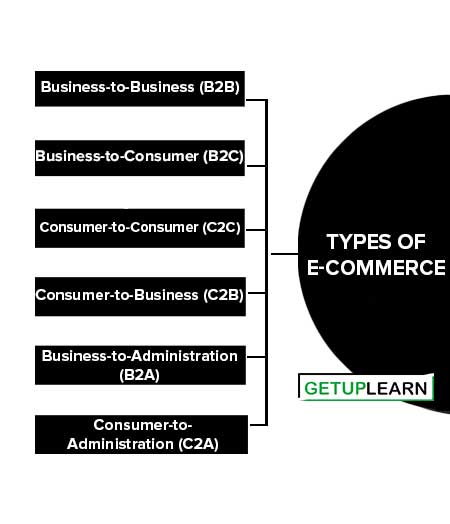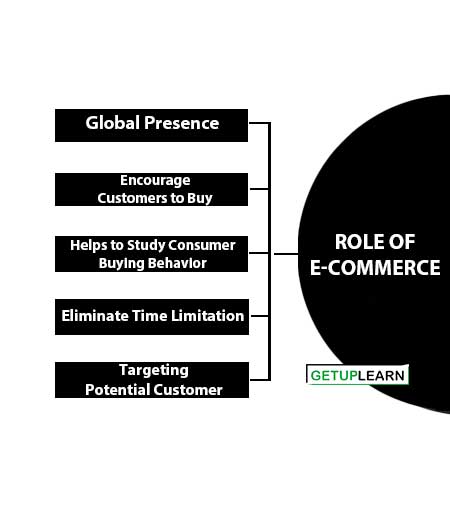Table of Contents
Meaning of E-Commerce
E-Commerce is the use of electronic mediums like the Internet, mobile phones, telephones, fax machines, etc. to carry on business activities and transfer information and funds for the smooth flow of business functions. In common terms, it is defined as a process of buying and selling goods online.
Electronic mediums, particularly the Internet, are increasingly becoming popular and have emerged as an integral part of modern-day business. It has helped producers to connect with customers in order to promote and sell products.
The Internet has become an important marketing tool that helps businesses to cut down their promotional cost while reaching a wide range of customers. Companies can now directly connect with their consumers in one go, surpassing middlemen and extensive distribution networks.
Types of E-Commerce
There are basically 6 types of e-commerce with different features. They are:
- Business-to-Business (B2B)
- Business-to-Consumer (B2C)
- Consumer-to-Consumer (C2C)
- Consumer-to-Business (C2B)
- Business-to-Administration (B2A)
- Consumer-to-Administration (C2A)

Business-to-Business (B2B)
Business-to-Business (B2B) includes electronic transactions of goods and services from one business to another. Businesses like software companies, office furniture, and supply companies, document hosting companies, etc fall under the B2B category of e-commerce. Eg: Boeing.
Business-to-Consumer (B2C)
Business-to-consumer (B2C) encompasses the electronic business relationship between the business and the final consumer. It is similar to the traditional retail model but business is conducted online rather than through a physical store. Eg: Flipkart.
Consumer-to-Consumer (C2C)
It includes transactions between consumers through electronic mediums. These are conducted through a third party who is the provider of the online platform where such transaction between customers takes place. E.g. OLX.
Consumer-to-Business (C2B)
It is a reverse form of transaction provided by online commerce where consumers provide their products and services to companies who are looking for them.
Business-to-Administration (B2A)
It includes electronic transactions between companies and public administration. Various services are provided in the areas of social security, employment, and other government-related operations through B2A. These transactions are increasing with the growing investments made in e-government.
Consumer-to-Administration (C2A)
It includes transactions between individuals and public administration conducted online. Its applications include filing tax returns, information, and payments about public services and e-health, etc.
Role of E-Commerce
E-Commerce has a huge role in today’s selling scenario. The varied application of e-commerce in selling has made it an indispensable part of all types of businesses. Following are some of the important roles of e-commerce in selling:
- Global Presence
- Encourage Customers to Buy
- Helps to Study Consumer Buying Behavior
- Eliminate Time Limitation
- Targeting Potential Customer

Global Presence
The major merit of e-commerce is its ability to make a global presence without making any major investments in physical presence.
Companies can now sell all over the globe and surpass the limitations of geographical barriers. Along with that customers also now have a varied choice and they can obtain all information regarding the products and services and compare between sellers regarding price, offers, and quality regardless of location.
Encourage Customers to Buy
E-Commerce helps companies to showcase their best-selling products along with reviews and feedback from other users which help to attract new buyers. With the help of attractive pictures and videos, an image can be created in the mind of the consumers which motivates them to purchase.
Helps to Study Consumer Buying Behavior
E-commerce allows companies to study the buying habits of customers through which they can provide tailor-made products and services to customers thus boosting the company’s sales. Providing the desired products and services also leads to higher customer satisfaction thus fostering a long-term relationship with the customers.
Eliminate Time Limitation
E-commerce surpasses the limitation of fixed timing for selling as in physical stores. Thus it helps in increasing sales by boosting the number of orders and also makes it convenient for customers to make purchases at any time that is suitable to them.
Targeting Potential Customer
E-commerce does help in locating potential customers by gaining access to data analysis about customers who visit the website for products or services. Through e-commerce, the customer’s name email address, and phone number can be easily collected and this can be used to communicate with the customers for making sales.
FAQs About the Role of E-Commerce in Selling
What are the roles of e-commerce?
These are some of the important roles of e-commerce in selling:
1. Global Presence
2. Encourage Customers to Buy
3. Helps to Study Consumer Buying Behavior
4. Eliminate Time Limitation
5. Targeting Potential Customers.
What are the types of e-commerce?
These are the 6 types of e-commerce:
1. Business-to-Business (B2B)
2. Business-to-Consumer (B2C)
3. Consumer-to-Consumer (C2C)
4. Consumer-to-Business (C2B)
5. Business-to-Administration (B2A)
6. Consumer-to-Administration (C2A).
